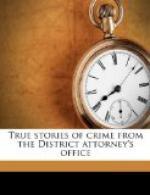A jury was procured after some difficulty, and the evidence of Mr. Levitan received, showing that Browne had represented Hubert to be a man of substance, and had produced an affidavit, purported to be sworn to by Hubert, to the same effect, with deeds alleged to have been signed by him. Mrs. Braman then swore that upon the same day Browne had himself acknowledged these very deeds and had sworn to the affidavit before her as a notary, under the name of William R. Hubert.
Taken with the fact that Browne had in open court stated that Hubert was a living man, this made out a prima facie case. But, of course, the District Attorney was unable to determine whether or not Browne would take the stand in his own behalf, or what his defence would be, and, in order to make assurance doubly sure, offered in evidence all the deeds to the property in question, thereby establishing the fact that it was originally part of the Petersen estate, and disclosing the means whereby it had eventually been recorded in the name of Hubert.
The prosecution then rested its case, and the burden shifted to the defence to explain how all these deeds, attested by Browne, came to be executed and recorded. It was indeed a difficult, if not impossible, task which the accused lawyer undertook when he went upon the stand. He again positively and vehemently denied that he had signed the name of Hubert to the deed which he had offered to Levitan, and persisted in the contention that Hubert was a real man, who sooner or later would turn up. He admitted knowing the Petersen family in a casual way, and said he had done some business for them, but stated that he had not heard of their tragic death until some years after the sinking of the Geiser. He had then ascertained that no one had appeared to lay claim to Mrs. Petersen’s estate, and he had accordingly taken it upon himself to adveritse for heirs. In due course Charles A. Clark had appeared and had deeded the property to Keilly, who in turn had conveyed it to O’Rourke. Just who this mysterious O’Rourke was he could not explain, nor could he account in any satisfactory manner for the recording in 1899 of the deed signed with Mary Petersen’s mark. He said that it had “turned up” in O’Rourke’s hands after O’Rourke had become possessed of the property through the action of the heirs, and that he had no recollection of ever having seen it before or having witnessed it. In the latter transactions, by which the property had been split up, he claimed to have acted only as attorney for the different grantors. He was unable to give the address or business of O’Rourke, Clark, Keilly or Freeman, and admitted that he had never seen any of them save at his own office. He was equally vague as to Hubert, whose New York residence he gave as 111 Fifth Avenue. No such person, however, had ever been known at that address.
[Illustration: With the exception of the upper left hand signature and the four immediately below it of H. Huffman Browne, these are all the signatures of imaginary persons invented by Browne to further his schemes. The upper right-hand slip shows the signatures to the Wilson bond, among which appears that of W.R. Hubert.]




